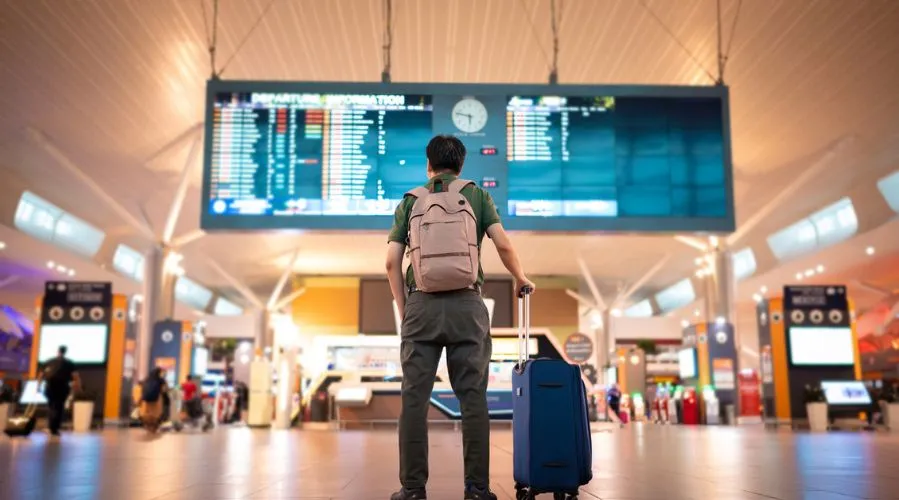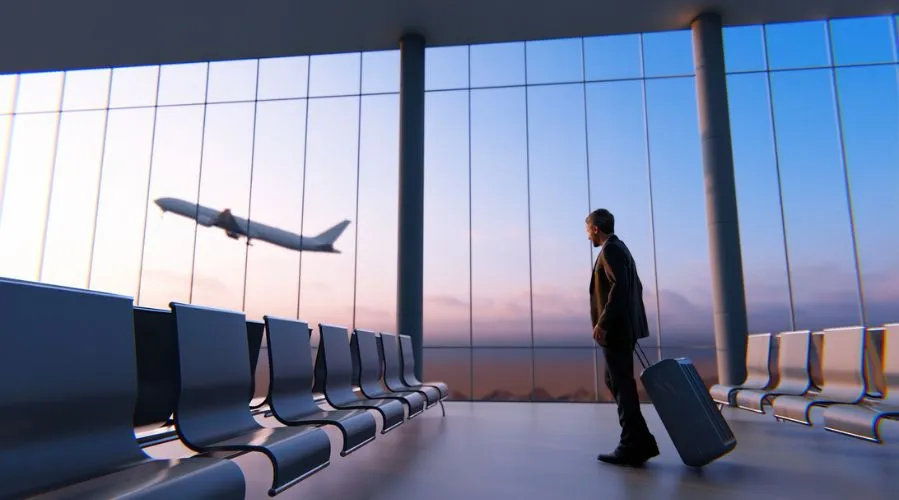Author: Kurt Hambadda
Date: 06/04/2025
A trip to Europe is often the opportunity of a lifetime. But with all there is to see and do, it can also often prove quite costly. So if you’re lucky enough to have someone paying your way — then more power to you! However, if you first need a Schengen visa to get there — then you’re also going to need a letter of sponsorship. In which case — fear not, because Schengen travel experts AXA have everything you need to know about getting, writing, and submitting one below.
- What is a Sponsorship Letter for a Schengen visa?
- Who needs a Sponsorship Letter for a Schengen visa?
- How to write a Sponsorship Letter – step-by-step guide
- 5 Tips for writing a Sponsorship Letter for a Schengen visa
- What supporting documents should be included with the Schengen visa Sponsorship Letter?
- How else can AXA help?
What is a Sponsorship Letter for a Schengen Visa?
A Sponsorship Letter for a Schengen visa is a formal document written by someone willing and able to cover the financial expenses of your trip to the Schengen Area (i.e., a sponsor).
The letter is often part of the mandatory Schengen visa application requirements for certain visa types — especially if you’re visiting friends or family in Europe.
In essence, the Schengen sponsorship letter is a signed document assuring the authorities of your European destination that your sponsor will take responsibility for your accommodation, living costs, and any other expenses you might have during your visit.
PRO-TIP: AXA can tell you more about the different types of Schengen visas and what they entail too.
Why is a Sponsorship Letter required by embassies for certain Schengen visa applicants?
Schengen embassies, consulates, and/or visa application centers require a sponsorship letter to ensure that visa applicants have sufficient financial backing for their stay (if they don’t have their own, that is).
As such, the letter reduces the risk of visa holders overstaying and/or becoming a financial burden on the host country. In this way, your sponsorship letter also verifies that you won’t be relying on the country’s public funds — and shows that your trip is both planned and supported.
Who needs a sponsorship letter for a Schengen visa?
You’ll most likely need a sponsorship letter if you need a Schengen visa to enter Europe, don’t have the funds to do so, but know someone who does (and is willing to help you out).
This applies to nationals from 100+ non-EU countries — and whether you're traveling for tourism, business, school, or to visit family and friends.
That said, a letter of sponsorship is especially common for the latter — i.e., people visiting friends or family. Because, after all, these are traditionally the people willing to invest in us most, right?
But whatever the case may be, if you're not footing the bill yourself and/or can't prove you’ve got the proper means of subsistence for your Schengen stay (after the initial Schengen visa costs, that is), Schengen authorities will ask to see who is backing you — and how.
PRO-TIP: AXA can also tell you if you need that Schengen visa or not in no time too.
Who can write a Sponsorship Letter?
Your sponsorship letter can be written by anyone willing to financially support you during your stay in the Schengen Zone.
This means your sponsor can be a family member or a friend, but it can also be your employer, business partner, or basically any individual or organization that’s got your back — officially and financially speaking.
The author of the letter of sponsorship doesn’t necessarily have to be in the Schengen either — or even a citizen or legal resident of a Schengen country. However, they must be willing to take responsibility for your stay there.
And, of course, your sponsor must be able to demonstrate to the Schengen authorities their ability to sponsor you. That is, that they have sufficient financial resources to support your visit — thereby formally ensuring that you won’t need to rely on public assistance.
How to write a Sponsorship Letter: a Step-by-Step guide
Writing a sponsorship letter can seem pretty daunting at first — but it’s actually fairly straightforward once you get down to it. So here’s AXA's simple step-by-step guide to creating a clear and concise letter (for both visa applicants and their sponsors):
Step 1: State the Purpose of the Letter
Begin by stating that you are writing to officially sponsor the Schengen visa applicant. Mention the relationship between you and the applicant (employee, relative, etc.) — and explain the purpose of their visit to the Schengen Area (i.e., work, family, and so on).
Step 2: Provide Personal and Contact Details
Include your full name, nationality, address, and contact details (phone number, email).
You’ll also need to provide the applicant’s full name, relationship to you, and the start/end dates of their intended visit.
Step 3: Outline Financial Responsibility
State clearly that you will be financially supporting the applicant. Mention the expenses you will cover — i.e., accommodation, travel, food, and any other relevant costs.
Step 4: Attach Supporting Documents
To verify your claims, include documents such as your financial statements, employment verification, and any other proof of financial stability (don’t worry — more on that below).
Step 5: Sign and Date the Letter
Finally, ensure that all the information above is accurate and truthful, sign the letter, and include the date.
In which language should the sponsorship letter be written?
The sponsorship letter should ideally be written in the official language of the Schengen country you are applying to.
However, if the country accepts documents in English (which they often do), you may write it in English. So always check the specific embassy’s, consulate’s, or visa application center’s requirements beforehand.
PRO-TIP: The European Union’s official website can save you some time here by providing links to all Schengen diplomatic missions worldwide.
What information should be included in a Sponsorship Letter?
As mentioned above, your sponsorship letter should typically include:
- Personal Details: Your full name, contact details, and relationship with the applicant.
- Financial Commitment: Clear indication of the financial support you’ll provide.
- Applicant’s Details: The applicant’s full name, nationality, and passport number.
- Trip Details: Purpose, dates, and duration of the visit.
- Additional Information: Any other relevant details or assurances (as required by the specific Schengen country’s authorities).
How detailed should the financial support section of the sponsorship letter be?
Don’t make it too wordy. However, the financial support section should be clear and detailed. So mention the exact expenses you will be covering — accommodation, travel, daily living expenses, studies, etc.
The more specific you are, the better — as this gives the Schengen authorities a clear understanding of the financial support provided.
IMPORTANT PRO-TIP: And make sure to double-check these numbers against the specific Schengen country’s means of subsistence requirements too.
5 Tips for writing a sponsorship letter for a Schengen visa
And to even further cover all your bases, here are five quick tips to ensure your sponsorship letter is clear, convincing, and meets all the requirements:
Tip 1: Be Honest and Accurate
Always provide truthful and accurate information. Falsifying details can result in visa denial (or even future entry bans).
Tip 2: Keep it Formal and Professional
Use a formal tone and professional language. The letter should not sound casual or overly familiar — as it is, after all, an official document.
Tip 3: Include All Necessary Documents
Make sure to attach all required supporting documents, such as proof of financial stability, identification, and so on (but don’t worry — more on that in a bit).
Tip 4: Be Specific About Financial Support
Clearly state the financial commitment — including the amounts and types of expenses you’ll cover. The more specificity, the more credible the letter.
Tip 5: Double-Check for Errors
And, finally, before submitting — check for any spelling or grammatical errors, and make sure all the details and numbers are correct too. An extra or a missing “0”, for example, can prove very costly in the long run!
Are there any templates available for a Schengen visa sponsorship letter?
Fortunately, yes. Many official government websites and visa assistance services will provide templates for sponsorship letters. As do less official sources on the internet.
But your best bet is to reach out to your destination country’s embassy (see the EU’s link above to find their contact info) for the specific guidelines and steps.
IMPORTANT PRO-TIP: Also note that different Schengen countries may have slightly different names for the letter of sponsorship too — such as the Netherlands’s Proof of Sponsorship form, Germany’s Declaration of Commitment (aka “Verpflichtungserklärungen”), and so on.
In other words, try to clarify as much as possible with a real person if you can — and preferably one that speaks your language.
Sample of a Sponsorship letter for a Schengen visa
Meanwhile, AXA also went ahead and did some digging and clicking around to find you a clear-cut sample — courtesy of trusted, worldwide Schengen visa application center VFS Global:
- Sponsorship letter template (in English)
PRO-TIP: But be sure to customize the template to your specific situation and adhere to your destination Schengen country’s official requirements.
What supporting documents should be included with the Schengen visa Sponsorship Letter?
Again, the specific Schengen state will tell you more — but here’s AXA’s breakdown of the supporting documents typically required alongside your sponsorship letter:
- Proof of sponsor’s financial stability (i.e., bank statements, salary slips, etc.);
- Sponsor’s passport or ID (verifying identity and legal status);
- Proof of relationship to applicant (i.e., birth certificates, photo IDs, or other official documents);
- Applicant’s travel details (your flight itinerary for the Schengen visa, hotel reservations, etc.).
FINAL PRO-TIP: And, of course, make sure you coordinate everything with your sponsor well beforehand. Since you’re basically their responsibility while in the Schengen, they will likely be able (and want) to fill in any gaps you might have regarding the process — especially if they’re a Schengen local.
How else can AXA help?
Hopefully, the above guide should be enough for you and your Schengen sponsor to start crafting that letter. And while AXA can’t necessarily be said sponsor, we do have your back with one more thing that should set you at ease — financially, legally, and in terms of your overall well-being in the Schengen.
And that’s some top-quality Schengen travel insurance for your journey.
After all, travel insurance is a mandatory requirement for being granted your Schengen visa (and that’s whether you’re being sponsored or not). And, fortunately, all of AXA’s plans meet the necessary criteria for being granted one.
Moreover, our plans are affordable, have no age limits, don’t require a medical exam, and have zero deductibles. Purchasing one, meanwhile, is easy and straightforward — and can be done online within minutes online.
And the world-renowned AXA travel insurance certificate is then accepted by all Schengen embassies, consulates, and visa application centers worldwide.
And, finally, our plans provide countless benefits for you once you’re actually in the Schengen zone — from 24/7 support to free remote medical consultation to coverage oflost items or documents to Schengen-wide support (and beyond). And much, much more! So make sure to
and
get a free AXA quote today.
Ultimately, a solid AXA plan is sure to make you, your sponsor, and the Schengen visa authorities that much more worry-free — both leading up to and throughout your entire stay in Europe!
RELATED ARTICLES:
- Invitation letter for a Schengen visa
- No objection letter for a Schengen visa
- Schengen visa validity
FAQ
What are the most common mistakes to avoid when writing a sponsorship letter for a Schengen visa?
The most common mistakes include leaving out key info (like travel dates or sponsor's details), giving vague financial info, not including supporting documents, and/or using overly informal or handwritten letters.
Should the sponsorship letter be handwritten or typed?
Typed (and usually printed). Most Schengen embassies expect formal, legible documents. Handwritten letters will generally be rejected. But make sure to check with the proper channels too.
Does my sponsor need to reside in the Schengen Area?
Not necessarily. The sponsor can live outside the Schengen Area — so long as they can formally prove they can support and accommodate you.
AXA already looks after millions of people around the world
With our travel insurance we can take great care of you too
AXA Schengen's Travel Insurances

AXA Schengen Basic
AXA Schengen Basic is perfect to obtain your Schengen visa. This travel insurance meets all the requirements demanded, covers you in all the countries of the Schengen Area as well as 4 European microstates (Andorra, Vatican City, Monaco and San Marino).

AXA Schengen Essential
AXA Essential is perfect to obtain your Schengen visa. It provides coverage in all the Schengen countries + the European microstates + all the EU countries (including UK, Cyprus and the Republic of Ireland). And you get additional guarantees compared to AXA Schengen Basic.

AXA Schengen Annual
AXA Annual is perfect to obtain your Schengen visa. This annual travel insurance is ideal for those who often travel to Europe as well as multiple-entry Schengen visa holders. You get the same guarantees as AXA Schengen Annual for different countries during 90 days.


